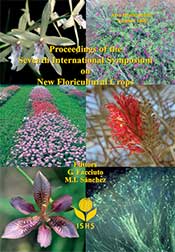Ver ítem
- xmlui.general.dspace_homeCentros e Institutos de InvestigaciónCIRN. Centro de Investigaciones de Recursos NaturalesInstituto de FloriculturaArtículos científicosxmlui.ArtifactBrowser.ItemViewer.trail
- Inicio
- Centros e Institutos de Investigación
- CIRN. Centro de Investigaciones de Recursos Naturales
- Instituto de Floricultura
- Artículos científicos
- Ver ítem
Structure and genetic diversity of three Calibrachoa caesia populations by ISSR markers
Resumen
Calibrachoa caesia is one of thirteen native species of the genus Calibrachoa Cerv. ex La Lave et Lexarza (Solanaceae) growing in Argentina. The genus has a high ornamental value due to the morphological variability that it shows for different genetic characters, including the flower colors. The structure and variation of 29 accessions from populations of three departments in the Province of Misiones (Oberá, Guaraní and San Ignacio) were analyzed by Inter
[ver mas...]
Calibrachoa caesia is one of thirteen native species of the genus Calibrachoa Cerv. ex La Lave et Lexarza (Solanaceae) growing in Argentina. The genus has a high ornamental value due to the morphological variability that it shows for different genetic characters, including the flower colors. The structure and variation of 29 accessions from populations of three departments in the Province of Misiones (Oberá, Guaraní and San Ignacio) were analyzed by Inter simple sequence repeat (ISSR) markers. Thirteen ISSR primers produced reproducible bands, with 652 amplified and 97.4% polymorphism. The polymorphism information content ranged from 0.144 to 0.170 for accessions from San Ignacio and Oberá populations, being the average 0.158, whereas the Shannon Index showed an average of 0.256. The principal coordinate analysis showed that the San Ignacio individuals were more disperse than the Guaraní and Oberá accessions. The analysis of molecular variance (AMOVA) test for Guaraní, Oberá and San Ignacio populations, showed highest genetic variation within populations (93.59%), meanwhile the Fst coefficient was 0.064, indicating a low to medium differentiation between populations, showing a great intrapopulation genetic diversity but no significant difference was detected among San Ignacio, Oberá and Guaraní populations. According to these results, the highly polymorphic level of the 29 analyzed individuals from the three locations represents an important source of genetic variability for future breeding programs
[Cerrar]

Fuente
Acta Horticulturae 1000 : 1-8 (2013)
Fecha
2013-07
Editorial
ISHS
ISSN
0567-7572
2406-6168
2406-6168
ISBN
978-90-66055-76-6
Formato
pdf
Tipo de documento
artículo
Palabras Claves
Derechos de acceso
Restringido
 Excepto donde se diga explicitamente, este item se publica bajo la siguiente descripción: Creative Commons Attribution-NonCommercial-ShareAlike 2.5 Unported (CC BY-NC-SA 2.5)
Excepto donde se diga explicitamente, este item se publica bajo la siguiente descripción: Creative Commons Attribution-NonCommercial-ShareAlike 2.5 Unported (CC BY-NC-SA 2.5)

